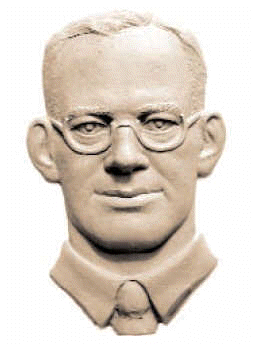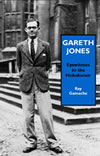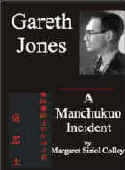Gareth Jones
[bas relief by Oleh Lesiuk]
HOME |
Stop Press |
Complete Soviet Articles & Background Information |
Précis of Gareth's
|
All Published Articles |
BOOKS
|
|
|
|
More Than Grain of Truth(2005) |
|
|
TOPICAL
'Are you Listening NYT?' U.N. Speech - Nov 2009 |
Gareth Recognised at Cambridge - Nov 2009 |
Reporter and the Genocide - Rome, March 2009 |
Order of Freedom Award -Nov 2008 |
Premiere of 'The Living' Documentary Kyiv - Nov 2008 |
Gareth Jones 'Famine' Diaries - Chicago 2008 |
Aberystwyth Memorial Plaque 2006 |
GENERAL
Scholarship Fund |
Site Map |
Links |
Legal Notices |
Sponsored Links |
Contact |
Hearst’s Russian Famine
By Louis Fischer
[Published in The Nation on 13th March 1935.]
New York, March 4
I have been reading Thomas Walker’s stories in the New York Evening Journal and other Hearst Newspapers about famine in Soviet Ukraine. These tales and accompanying photographs are so fantastic and unreal, and so unlike the Soviet Ukraine which I visited in July and August of 1934 that my suspicions were aroused.
Thomas Walker, the editorial note tells us is a “noted journalist and traveler and student of Russian affairs, who for several years has toured the Union of Soviet Republics.” I have never heard of him and I can fine no-one who has. But let that pass. Mr. Walker, we are informed, “entered Russia last spring,” that is the spring of 1934. He saw famine. He photographed its victims. He got heartrending, first-hand accounts of hunger’s ravages. Now famine in Russia is “hot” news. Why did Mr. Walker or Mr. Hearst keep these sensational articles for ten months before printing them? My suspicions grew deeper.
On November 28, 1930 the London Daily Telegraph printed a two column interview with Frank Easton Woodhead, a British engineer “who has just returned from Russia after a visit lasting seven months.” On November 11, according to this interview, Mr. Woodhead saw a battle in the barracks square in the center of Moscow between G.P.U. troops and the regular army. The soldiers, he reports, “were butchered by the O.G.P.U…. Soon after the firing had ceased I saw several hundred men led-out by the O.G.P.U. They were chained together in groups.”
On the very next day the ubiquitous Woodhead was in Pushkin, a village near Moscow, where he watched the slaughter of innocent peasants by a Red Army detachment. “It was generally said” he reported, “that the casualties were between four and five hundred. I do not know, but judging by the number of bodied I saw lying about, I should without hesitation accept the estimate.”
Three days later food riots broke out in Moscow, Woodhead reported. “In the afternoon, we could hear firing from the hotel. It continued from 2:30 to 5: We were told that many people had been killed, and that night, when an American friend and I went to the Opera House, we saw gruesome evidence of what had happened. On the outer edge of the square there were rows of ghastly corpses.”
All this of course, was a tissue of lies. These things could not have happened. I was in Moscow at the time and investigated Mr. Woodhead at the police headquarters, where all foreigners register on entering and leaving the U.S.S.R. I discovered that he had left Moscow on May 8, 1930 for Poland, and had never returned. Mr. Woodhead, therefore was not in Moscow in November when the bloody events he “saw” are supposed to have taken place.
I published my rebuttal of the Daily Telegraph interview in the New Republic of June 10, 1931. My article was reprinted in England, and was never denied or contradicted. It could not have been.
On reading Mr. Thomas Walker in the Hearst press on thinking over the whole situation, I felt more and more sure he was just another Woodhead, another absentee journalist. And so I consulted Soviet authorities who had official information from Moscow. Thomas Walker was in the Soviet Union once. He received a transit visa from the Soviet Consul in London on September 29, 1934. (Not the spring of 1934 as he says.) He was in Moscow on the thirteenth. He remained from Saturday, the thirteenth, to Thursday the eighteenth, and then boarded a trans-Siberian train, which brought him to the Soviet-Manchurian border on October 25, 1934, his last day on Soviet territory. His train did not pass within several hundred miles of the black soil and Ukrainian districts which he “toured” and “saw” and “walked over” and “photographed.” It would have been physically impossible for Mr. Walker, in the five days between October 13 and October 18, to cover one-third of the points he “describes” from personal experience. My hypothesis is that he stayed long enough in Moscow to gather from embittered foreigners the Ukrainian “local color” he needed to give his articles the fake verisimilitude they possess.
Mr. Walker’s photographs could easily date back to the Volga famine in 1921. Many of them might have been taken outside of the Soviet Union. They were taken at different seasons of the year: anybody can see that by looking at the vegetation and the clothes of the people. One picture includes trees or shrubs with large leaves. Such leaves could not have grown by the “late spring” of Mr. Walker’s alleged visit. Other photographs show winter and early fall backgrounds. Here is the Journal of the twenty-seventh. A starving bloated boy of fifteen calmly poses naked for Mr. Walker. The next moment in the same village, Mr. Walker photographs a man who is obviously suffering from the cold despite his sheepskin overcoat. The weather that spring must have been as unreliable as Mr. Walker to allow nude poses one moment and require furs the next.
It would be easy to riddle Mr. Walker’s stories. They do not deserve the effort. The truth is that the Soviet harvest of 1933, including the Soviet Ukraine’s harvest, in contrast to that of 1932, was excellent; the grain-tax collections were moderate; and therefore conditions even remotely resembling those Mr. Walker portrays could not have arisen in the spring of 1934, and did not arise.
Why, then, does the Hearst press publish these “revelations”? Mr. Hearst, naturally does not object if his papers spoil Soviet-American relations and encourage foreign nations with hostile military designs upon the USSR. But his real target is the American radical movement. These Walker articles are part of Hearst’s anti-red campaign. He knows that the great economic progress registered by the Soviet Union since 1929, when the capitalist world dropped into depression, provides left groups with spiritual encouragement and faith. Mr. Hearst wants to deprive them of that encouragement and faith by painting a picture of ruin and death in the USSR. The attempt is too transparent, and the hands are too unclean to succeed.
P.S. Would the Hearst press oblige us with a photograph of Mr. Thomas Walker, and with facsimiles of his United States passport and of the Soviet visa stamped upon it?
P.S. No. 2. On February 26, the
Moscow Izvestia printed a lengthy interview with Lindsay Parrot who
had just taken a trip through the Ukraine. He really was in the Ukraine.
“Nowhere” says Mr. Parrott, “in any of the cities or villages visited, not
along the road, did I meet any signs of the effects of the famine of which
foreign correspondents take delight in writing.” He goes on to speak the
“excellent harvest” in 1933. “The progress,” he declares, “is indisputable.”
“In the light of these facts,” Mr. Parrott concluded, “I can understand the
statement of the local chairman of the district executive committee, Mertz,
to the effect that the collective farmers reject the assistance of the
fascist organization especially established in Germany to help the Germans
allegedly suffering from famine in Russia.” The Hearst press in America made
a similar appeal for aid for the alleged famine victims. The Hearst
organization and the Nazis are beginning to work more and more closely
together. But I have not noticed that the Hearst press printed Mr. Parrott’s
stories about a prosperous Soviet Ukraine. Mr. Parrot is Hearst’s
correspondent in Moscow.
|
|
|
|



